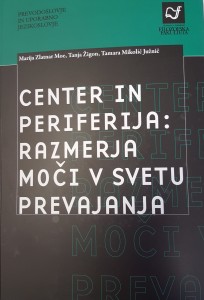 Das Buch über die Machtverhältnisse in der Welt der Übersetzung (Autorinnen: Marija Zlatnar Moe, Tanja Žigon und Tamara Mikolič Južnič; Ljublljana: Znanstvena založba Filozofske fakultete 2015) ist erschienen und kann hier bestellt werden.
Das Buch über die Machtverhältnisse in der Welt der Übersetzung (Autorinnen: Marija Zlatnar Moe, Tanja Žigon und Tamara Mikolič Južnič; Ljublljana: Znanstvena založba Filozofske fakultete 2015) ist erschienen und kann hier bestellt werden.
Abstract:
Centre and Periphery: Power Relations in the World of Translation deals with relations between languages taking part in the translation process. Those relations are not equal, as different languages occupy different positions in the global language and translation systems. While some factors that influence the relative prestige and position of a particular language and culture – such as the number of speakers or the economic importance of the country in which the language is spoken – are obvious, there are other, subtler factors at work, such as the cultural capital of a language community (Bourdieu 1986), and the position that community holds within the global language, literary or translation system (De Swaan 2001, Casanova 2002, Heilbron 2000). Based on theories derived from Wallerstein’s (2004) world system theory, we discuss not only the relations between the centre and the periphery, but rather a much more complex network of relations, including the various interactions between the hyper-central, central, semi-peripheral and peripheral languages.
This book focuses on the influence the position of a language has on translation and other forms of interlingual mediation. In our research on different combinations of languages, text types, literary genres and translators of varying competence, we found that certain translational paradigms appear to be typical of peripheral language pairs. Our research turned to the ways in which the position of each particular language within the system influences translation on the macro level (translation policy, quantity, directness of translation, and genres of translated texts) as well as on the micro level of individual translation decisions and strategies within a particular text, sentence or phrase. In our research, we tested the following hypotheses:
- The definition of a language as central or peripheral is based on the model of the global translation system (cf. Heilbron 1999), but those positions are not fixed; they can change over time, or vary temporarily under given circumstances;
- On the macro level, the translation process differs between central and peripheral languages, in terms of the reasons for a translation, the selection process, quantity and types of translators, etc.
- Differences can be observed also on the micro level, in the most frequently used translation strategies, especially when dealing with culture-specific elements of the source text;
- Regardless of a language’s position within the global system, its position is always hyper-central for the native speakers of that language; communication may be impeded by the speaker’s/writer’s lack of proficiency in the mother tongue, as the latter enables and influences all interlingual contact and mediation.
We begin with a description of the theoretical basis of the language/translation system, showing that the position of a language within it is fluid and can change with time and (historical, political or other) circumstances, but also that this position influences everything, from the probability that two languages will come into direct contact and in what manner, to the micro-level individual translation decisions.
In the following chapters we present the results of the individual studies of intercultural and interlingual contacts between hyper-central, central, semi-peripheral and peripheral languages on the one side, and the Slovene language on the other side, each in its way addressing the theoretical questions from the opening chapter.
The second chapter thus presents publishing practices in literary translation from different languages and cultures, based on data collected from the Slovene Bibliographic Co-operative On-line System and Services (COBISS), and from the participants in the translation process, namely, translators, editors, publishers and patrons (institutions who offer financial and/or other support for literary translations from individual languages).
The third chapter presents case studies of literary and non-literary translations between Slovene and various other languages, showing how individual translation decisions are influenced in practice by the source and target languages’ position within the language system.
The final chapter deals with the role played by the mother tongue in all interlingual contacts and communication, regardless of its importance in the world, and calls for ongoing, life-long mother-tongue education in order to enable its speakers to understand and be understood not only within their own language community, but also outside it.
In the conclusion, we present the summary of all our research results and test them against the hypotheses presented in the introduction. In this manner, we present a complete picture of what it means to translate from and into a peripheral language, such as Slovene, and what influences those translations.


